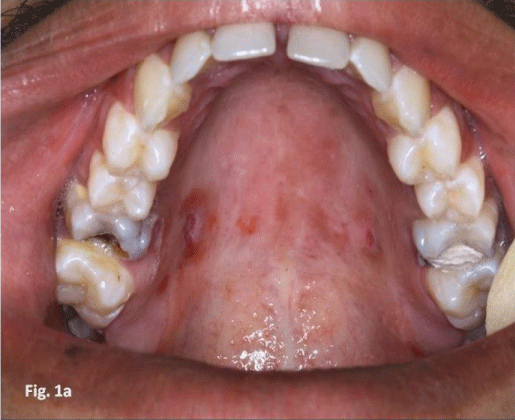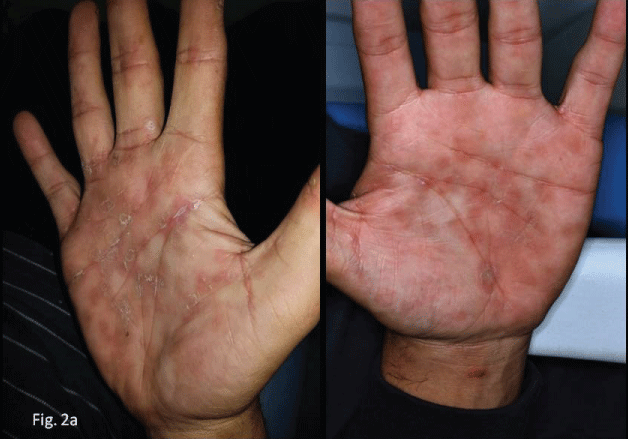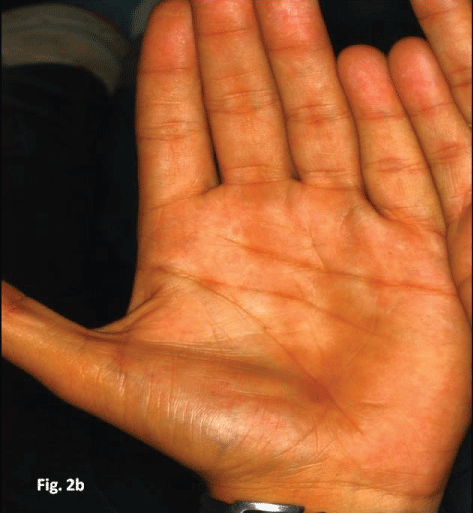This article reports a case of secondary stage syphilis involving the oral mucosa and the skin (the palms). The lesion's clinical aspects of both sites could possibly be misdiagnosed for some common inflammatory diseases, among them oral lichenoid contact lesion or drug reaction. As a standard procedure, the differential diagnosis required to rule out syphilis. The treponemal and anti-treponemal tests confirmed the diagnosis of syphilis. The patient was successfully treated, but, unfortunately, his partners from sexual encounters were left unaccounted for. People who contract syphilis and are left untreated jeopardize society. This is the main reason why syphilis cannot be easily controlled from spreading.
Oral lesions, Erythematous spots, Skin lesions, Circinated lesions, Differential diagnosis, Serological tests
Syphilis, a millennial disease, keeps making its way among population worldwide despite the high efficacy of penicillin treatment. Before the penicillin era, syphilis had claimed many lives; one of its most famous victims was Alphonso Capone, better known as "Al Capone", a Chicago racketeer from the 1930s. Unfortunately, at the time he was diagnosed as having syphilis, no cure was available for the disease; he eventually died of neurosyphilis, this being the most fearful complication of syphilis on its tertiary stage [1].
Syphilis is an infection disease caused by Treponema pallidum. It is transmitted predominantly by sexual contact; the second most common route of transmission is across the placenta with this type of transmission being more common in underdeveloped societies [2].
After the discovering of penicillin, the disease had almost-but only almost-disappeared from all corners of the world. According to the findings from a remarkable epidemiological study, involving 154 countries, using meta-analyses and meta-regressions, conducted from 1990-2016, showed that the median prevalence for syphilis worldwide was 1.4% [3]. This study also points to a decline of the prevalence rate of syphilis in the general population.
However, from time to time the disease subtly comes to our clinic and, in many instances, poses difficulty for a clinical diagnosis. The difficulty in making a clinical suspicion of syphilis arises mostly from its great array of clinical manifestations, which, indeed, can mimic almost any dermatological diseases [4,5]. A common thought (and attitude) among clinicians is that when you do not know what it is, make syphilis as a possible diagnosis and screen the case serologically.
This article adds some knowledge on syphilis by reporting a case that shows a combination of oral and skin manifestations in the secondary stage of this disease.
A 28-year-old white male came to our clinic complaining of sore mouth that had been present for 3 weeks. Clinical examination showed that he had a poor dental health with some teeth in advanced decaying stage; additionally, there was the presence of multiple erythematous maculae and erosive rounded spots on the hard palate mucosa (Figure 1). Cervical lymphadenopathy was present, characterized by two rounded, mobile, asymptomatic lymph nodes, bilaterally, which was later interpreted as an immunological response to the dental and gingival infection. He also reported a concomitant appearance of lesions on the palms characterized by multiple rounded erythematous spots along with scaly circinated lesions (Figure 2). The patient was not complaining of any symptoms, such as fever or malaise. His medical history was uneventful. He was neither a smoker nor a habitual consumer of alcoholic beverages.
 Figure 1: A few lesions of erosive and erythematous pattern on the hard palate along with the poor oral health.
View Figure 1
Figure 1: A few lesions of erosive and erythematous pattern on the hard palate along with the poor oral health.
View Figure 1
 Figure 2: Erythematous and scaly lesions on the palms.
View Figure 2
Figure 2: Erythematous and scaly lesions on the palms.
View Figure 2
What a diagnosis could possibly be made for these oral and skin lesions? For those oral red spot, the differential diagnosis would include oral lichenoid reactions to drug (OLRD), autoimmune disease, such as pemphigoid of membrane mucosa (PMM), erythematous candidosis, oral mucosal contact reaction (OMCR) and secondary syphilis. OLRD is hard to diagnosis. It is necessary to correlate with a systemic medication by withdrawing the implied medication and to observe whether the oral lesions disappear and by re-introducing the medication to further observe whether the lesions reappear. This is quite difficult (if not impossible) to perform since, in most cases, patients cannot have their medications withdrawn for significant amount of time; furthermore, OLRD is quite an uncommon manifestation. In the present case, it was ruled out since the patient was not taking any sort of medication. For PMM, besides the lesions' morphology of the present case not being consistent with those of PMM (mainly due to the lesions on the palms), the disease is very uncommon in men and even more in the young. Therefore, it was also ruled out. Erythematous candidiasis was excluded after a negative test for pseudohyphae under direct examination with 10% KOH. For OMCR, this could be a very consistent diagnosis, but because of the presence of the skin lesions, the possibility of OMCR was also ruled out. The last, but not the least, a secondary stage of syphilis was very suggestive. For that, a laboratory tests were required and the syphilis diagnosis was confirmed by VDRL (venereal disease research laboratory) test (titers 1:32) and a positive reaction to TP-PA (Treponema pallidum particle agglutination assay). The patient was additionally tested for HVI, resulting as nonreagent.
Usually two serological tests are required for a diagnosis of syphilis: Nontreponemal tests for screening and treponemal tests for confirmation. The Venereal Disease Research Laboratory (VDRL) is the most common nontreponemal test, becoming positive one to four weeks after the appearance of the primary chancre. This test is also used for monitoring the efficacy of the treatment. The treponemal test used here was the Treponema pallidum particle agglutination (TP-PA) test, which is a qualitative assay for the detection of antibodies to T. pallidum in serum or plasma, and it is one of the more commonly used treponemal tests. The TP-PA test is less expensive and less complicated than the fluorescent treponemal antibody absorption (FTA-ABS), also being a very reliable treponemal test [6,7].
The patient was sent to a reference center for Infectious disease for treatment and monitoring. According to the report made by the physician, the patient was treated with a single dose of Benzathine penicillin G 2.4 million units. Afterwards, he was seen at our clinic 6 weeks later, with the palatal oral mucosa completed cleared of the lesions while, on the palms, lesions were most likely in their the final process of remission (Figure 3 and Figure 4). The patient is still being monitored for titer decline.
 Figure 3: The appearance of the palatal mucosa following penicillin treatment.
View Figure 3
Figure 3: The appearance of the palatal mucosa following penicillin treatment.
View Figure 3
 Figure 4: The appearance of the palm after treatment, there yet being some erythematous spots in progress of healing.
View Figure 4
Figure 4: The appearance of the palm after treatment, there yet being some erythematous spots in progress of healing.
View Figure 4
As widely known, syphilis can imitate almost any sort of dermatological disease, thereby a clinical diagnosis of this disease can, in some instances, be very difficult. As often as not, the serological test for syphilis has become a common procedure when a clinician faces cases featuring erythematous patches, exanthematous or serpiginous rash, or even for a symptomless isolated chancre, as a safeguard to avoid missing a diagnosis of a disease that can go into a latent form if left untreated [6,8].
The clinical diagnosis of the present case was highly supported by lesions on the palm of both hands characterized mainly by multiple red spots and scaling. These types of lesions are also seen as a typical manifestation as side-effects of many drugs, particularly non-steroids anti-inflammatory drugs and antibiotics [1,9]. The clinical presentation of the current case can be, therefore, described as a classical example of syphilis manifestation mimicking a drug reaction. The skin findings were corroborated by the oral ones, which, by its turn, could also resemble some other oral diseases (as was discussed above) and, hence, reinforcing the syphilis' ability to imitate a great array of mucosal and skin diseases. As the patient was not using any medication (either systemically or topically) a possibility of syphilis was thought over and, later, confirmed with serological tests.
In spite of syphilis (particularly in its secondary stage) being a truly imitator of many other diseases (it can even imitate malignant processes such as lymphoma), its oral manifestations are better known by the presence of multiple mucous patches characterized by slightly elevated plaque covered with a transparent gray to white pseudomembrane, making them resemble snail-tracks [7,8]. The present case lacks this manifestation, hence increasing the difficulty for a clinical diagnosis. The bilateral, cervical lymphadenopathy observed in the patient has not changed after he returned from the treatment for his disease. That finding was then judged as a lymphadenopathy in response to the dental and periodontal infection.
As a typical member of STD (sexually transmitted disease), making the diagnosis and treatment of a syphilis-case does not end the case in itself. In addition to control the rate of decline of antibody titers following antibiotic therapy, it is overwhelming important to search for the partner(s) with whom the patient had had a sexual intercourse. This effort almost always comes as unrewarding attempt since most of the individuals infected (and left untreated) by the Treponema pallidum go unaccounted for, a social drama that has caused the spread of the disease since the Ancient times [6,7].
Patients with the secondary stage of syphilis (as seen in the present case) may not seek for treatment. Cases that go untreated will follow one of these possible paths: this: one-third will have the disease remitting spontaneously and will become nonreactive serologically; another third will be clinically free of the disease but will remain positive for serological tests. The remaining third of the untreated cases will develop the manifestations of the tertiary stage of the disease, among them, most critically, are cardiovascular syphilis or neurosyphilis. At least 25 percent of these patients will die from complications of the disease [1,10]. As stated in Introduction section, syphilis can still claim lives. Al Capone met his fate by developing neurosyphilis and, eventually, dying of this complication.